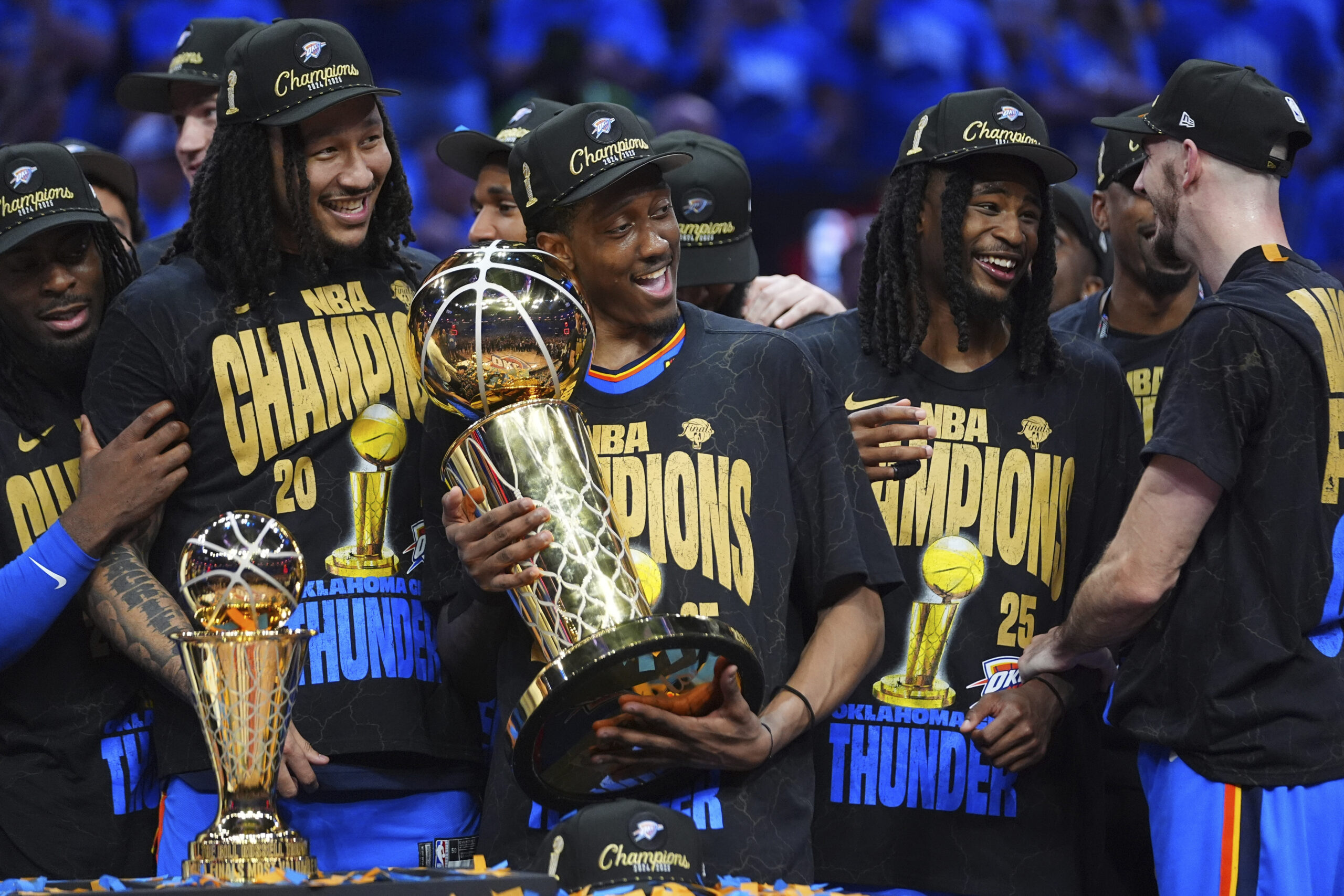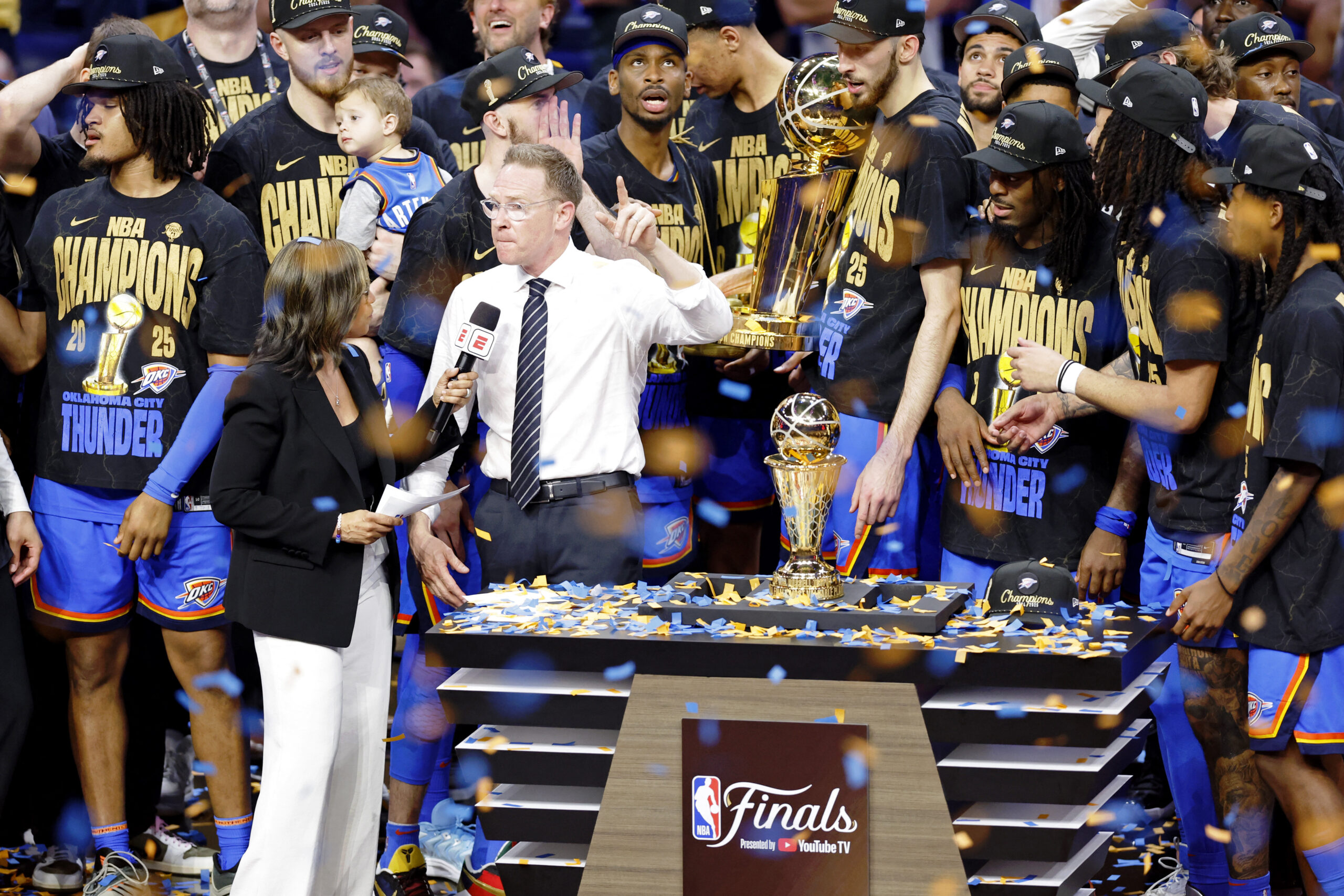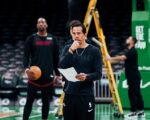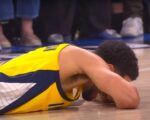T.J. McConnell was trapped. It was late in the third quarter of Game 7 of the 2025 NBA Finals, and the 33-year-old vet found himself 45 feet away from the basket cornered by the outstretched arms of Isaiah Hartenstein and Alex Caruso. The OKC defenders were the offseason acquisitions of executive VP of basketball operations Sam Presti, doing exactly what the Thunder envisioned when they brought them in: suffocating the opponent in a huge championship spot.
McConnell couldn’t escape, and Hartenstein snatched away his desperate attempt to pass out of checkmate. If you blinked you would have missed what happened next. Hartenstein, a 7-foot center, flung a perfect touchdown pass to 21-year-old guard Cason Wallace, who outran the Pacers defense and reeled it in like a wide receiver in a dead sprint. Wallace finished the layup over Aaron Nesmith to go up nine. The Thunder never looked back. The 2025 championship was theirs.
This was the quintessential Thunder play. Ferocious defense turning into quick offense. Wallace’s layup added to the Thunder’s eventual decisive 32-10 points-off-turnovers margin in the biggest game of their lives. The Thunder completed the postseason with the largest turnover gap in NBA history, per Stathead.com.
But the Wallace layup was also symbolic of the Thunder’s deadly weapon: youthful speed. With an average minutes-weighted age of 24.7 years old, the Thunder are the youngest champion since the 1977 Portland Trail Blazers. It’s a young man’s league now and McConnell, who tallied a career-high seven turnovers as the oldest rotation player in the Finals filling in for the injured Tyrese Haliburton, simply couldn’t keep up with the Thunder’s youth.
It’s not just McConnell. The Thunder are outrunning everybody. It’s a copycat league, but it’ll be almost impossible for others to trace the Thunder blueprint. Oklahoma City broke all the unwritten rules about what champions are supposed to look like. Young teams shouldn’t be this good. They play fast and they play hard. They won by playing speedball and now they have a headstart on the rest of the league.
‘Shortcuts run long run short’
A bearded Presti stood in front of the camera and delivered his end-of-season address with gratitude. You would never have known his team had just lost 50 of 72 games.
This was late May of 2021 and the team’s longtime chief decision-maker wasn’t taking questions from the present media as he typically does for his end-of-season news conference. Not because the team just finished with just 22 wins, the fewest since the franchise moved out of Seattle. But because the league was still navigating social-distancing protocols of its first full season since the COVID-19 pandemic.
Presti took his time. He opened his 20-minute uninterrupted speech by thanking medical professionals, families and the league for safely completing the grueling season that called for 72 games in 141 days. The executive spoke highly of their new coach, Mark Daigneault, in his first season out of the G League. Presti then praised the team’s emerging star, Shai Gilgeous-Alexander, who played brilliantly for 35 games before his season was prematurely ended by a foot injury. After overseeing the organization’s first losing season in 12 years, Presti preached positivity with his young group and closed with a message to the fans — a call for patience.
“Shortcuts cut long runs short,” Presti said. “And we’re going to do everything in our power to not let that happen. And when we do get back to the postseason, we want it to be an arrival, and not an appearance.”
Sure enough, the slow-build gradually delivered a playoff showing for Gilgeous-Alexander, Daigneault and the Thunder just three seasons later in 2024. Just as Presti hoped, they didn’t just make an appearance. They arrived and have now conquered, winning the NBA championship in just the second postseason of the core’s tenure.
Presti didn’t consciously accelerate the Thunder’s timetable. They just happened to find the next big thing before anyone else did: speed.
The speedball system
About halfway through Presti’s 20-minute speech in 2021, we received our first mention of actual basketball. And it was a peculiar one, that now feels wholly prescient. Presti presented an obscure stat that he believed had illustrated the hallmark of the team. In the 2020-21 season, Presti pointed out, the Thunder were elite at contesting 3s.
“I think we all know that the NBA has turned into a 3-point shooting exhibition,” Presti said that May. “It makes it extremely exciting for fans. We were second in the league in contesting a 3-point shot this season. As we know, that’s one of the hardest things to do in the NBA with all the spacing today. I think it was a great indication of the effort and how hard our guys played on a night-to-night basis. We were a young team clearly, we were inexperienced on most nights that we played. But our effort and our stick-to-itiveness was exceptional.”
OKC was young and inexperienced in 2020-21 and, by championship standards, they are young and inexperienced now. But that youthfulness never deterred them from continuing to play harder than anybody else who took the floor, whether it was chasing 3s, zipping to closeouts or hunting turnovers.
Welcome to OKC’s speedball.
With a whirlwind fleet of wing defenders indoctrinated in Daigneault’s high-effort system, the Thunder raced around the floor with unbridled physicality and intent. On average, Thunder defenders covered 8.8 miles of ground per game this postseason which marks the highest total for any champion in the player-tracking era, per NBA.com advanced stats data. With long wingspans and acute anticipation, they hounded opponents so relentlessly that they became the first team since hustle stats were publicly tracked in 2015 to average more than 20 deflections per game in the postseason.
Is effort replicable? Is culture something that other teams can Xerox?
Good luck.
Under Presti and Daigneault, the Thunder spent years incubating and establishing an organizational standard that demanded energy, focus and selflessness. They identified prospects that fit that profile and developed them in their system. Youthful rosters are usually losing outfits. The Washington Wizards, the NBA’s youngest team, won 18 games. The Thunder won 18 games from Thanksgiving to Jan. 10, practically over Christmas break.
This didn’t happen by accident. They picked up Lu Dort after he went undrafted in 2019 and developed him into an All-Defensive wing and a knockdown 3-point shooter. They grabbed Jalen Williams at No. 12 in the 2022 draft, an unheralded prospect who, until days before the draft, was expected to be a late second-round pick. They took the paper-thin 7-foot Chet Holmgren at No. 2 in 2022, and he became one of the game’s elite rim protectors in his age-22 season. They traded up to take Cason Wallace at No. 10 in 2023, a defensive-minded guy who averaged 11.7 points at Kentucky, and he was starting games in the NBA Finals shy of his 22nd birthday.
It’s clear that the Thunder brass targeted these players because they believed they could thrive in Daigneault’s demanding environment. The team played at the sixth-fastest pace in the league this season with the largest turnover differential in NBA history. To play with that level of effort and endurance, the Thunder had to break the mold. They had to win with youth.
The first Gen Z champ
As Presti expressed in his 2021 postseason presser, the pace-and-space revolution in the NBA has undoubtedly created a more exciting product for fans. But the 2024-25 postseason, accentuated by Haliburton’s devastating Achilles injury in the opening minutes of Game 7, has hammered home the point that the expanded geometry and accelerated pace comes at a cost.
The NBA has increasingly become a young man’s game. Games in modern times regularly feature at least 100 possessions, something that rarely happened in past eras dominated by older vets. Golden State coach Steve Kerr told me last month that the game is so fast and spaced out that it’s becoming harder and harder for veteran players to stay healthy for a full 82-game season and then compete at the highest levels in the postseason.
Jayson Tatum, in his eighth postseason run, and Damian Lillard, in his 10th postseason run, both suffered devastating Achilles ruptures this playoffs. And they weren’t alone in the landscape of sidelined stars; Stephen Curry, Darius Garland and Evan Mobley joined the list of 2025 All-Stars that missed playoff games due to injury this postseason.
Perhaps it’s no coincidence that the NBA Finals matchup featured two Gen Z teams that are powered by youngsters, not greying vets, whose less-mileaged bodies may be able to withstand the rigors of the season better than their older peers. The Thunder’s average minutes-weighted age (to account for playing time) of 24.7 years old cemented them as the youngest champion in almost a half century. The Pacers, with an average age of 26.2 years old, followed a similar blueprint, upending the older Bucks, Cavs and Knicks en route to the Finals. But Haliburton, fighting through what the team deemed a right calf strain, collapsed in a heap in the first quarter after trying to escape the Thunder defense following a remarkable string of three deep 3-pointers in Game 7. It’s the second time in the last two postseasons that Haliburton’s season was cut short due to injury.
In all likelihood, the Thunder recognized where the league was going and built a youthful roster that could capitalize on the growing geometry. The concept of “young legs” is demonstrated in the cold, hard numbers. According to data collected from the NBA.com player-tracking data, the average speed of NBA players gradually falls as the pros get older. This past season, a 20-year-old covered 7 percent more ground than a 30-year-old. In a 48-minute game, that could amount to not just hundreds of feet in additional coverage by a team, but an expanded footprint that could be measured in miles.
The Thunder’s youth is also something that’s not easily transferable to other teams looking to follow their lead. Good young players are usually locked into long-term contracts with their respective teams, not readily available on the free agency market. Thanks to the new CBA that incentivizes players to sign extensions with their current club, long gone are the days when teams could sign a superstar in free agency and build a championship contender overnight. And trading for a good young player is costly in ways that adding a key cog in free agency is not; in trades, you have to give up something in order to get something.
To copy the Thunder blueprint, a team would have to routinely hit home runs in the draft, a notion that is easier said than done. Presti and his front office have continued to nail prospect evaluation and development at a higher rate than their peers. The franchise’s five top-5 picks since Presti took over basketball ops in 2007 — Kevin Durant (No. 2 in 2007), Russell Westbrook (No. 4 in 2008), James Harden (No. 3 in 2009), Jeff Green (No. 5 in 2007) and Chet Holmgren (No. 2 in 2022) — is the stuff of legend. The team also selected future All-Stars Jalen Williams (12th) and Domantas Sabonis (11th) outside of the top 10 in addition to NBA lifers Serge Ibaka (24th), Steven Adams (12th) and Reggie Jackson (24th).
Consider that until this season, when Houston’s Alperen Şengün was selected to the All-Star squad, the Rockets had not drafted an All-Star during the 18-year span Presti has been in charge of the Thunder. (In a comical twist, the Thunder technically drafted Şengün with the 16th pick and then traded him to Houston for future firsts on draft night.)
Because of their eye for young talent, the Thunder can restock a deep rotation with contributors without taxing their stars. Gilgeous-Alexander just won Finals MVP while averaging a modest 38.1 minutes per game, one of the lowest for the top minutes-getter on a championship team. In fact, it’s the first time since the NBA/ABA merger that the champion had only one player average over 35 minutes per game in the Finals, per Stathead.com tracking.
The Thunder could continue to replenish their roster through the draft. Because if draft-and-develop is the new path to championships, the Thunder are better equipped to dominate that realm than any champ in recent history.

No shortcuts, no ceiling
Champions aren’t supposed to be this lean. The typical champion — like the 2024 Boston Celtics who paid $44 million in luxury tax payments when they won it all a year ago — is capped out on the books and tapped out in the asset department. NBA Finals winners, according to Sportico research, have been forced to pay the luxury tax in 14 of the last 18 years.
The Thunder are the exception in this sense as well, sitting about $9 million under the luxury tax threshold this season. Remarkably, the champs are expected to duck the tax again next season while a whopping 10 teams are currently projected to cross that line in 2025-26, according to Spotrac.com tracking. That list includes two West teams — Phoenix and Dallas — who didn’t even make the playoffs.
It’s a brilliant stroke of roster management by Presti and his front office. Saving billionaire owners some extra cash isn’t what should excite the Thunder fanbase; it’s having all the cards in roster construction without running up against stiff salary apron rules that have hamstrung other franchises.
In this sense, the champion Thunder can have their cake and eat it, too. For instance, by staying below the second apron, the Thunder could aggregate salaries — say, the contracts of Hartenstein and Dort — in case a star player like Giannis Antetokounmpo becomes available. Contrast that to the Cavaliers, a second-apron team. If they wanted to go after a player of Antetokounmpo’s caliber, they couldn’t combine salaries or take back more money in a trade, almost nullifying any chance of getting a two-team deal done.
And so the Thunder can sit on their throne with plenty of riches at their disposal. OKC is one year away from any semblance of financial hardship when Holmgren and Williams’ extensions are expected to kick in during the 2026-27 season, likely at the max number. They also have two seasons of cushion until Gilgeous-Alexander’s mammoth extension kicks in starting in 2027-28. The Thunder will gladly pay that, considering the fact that over the next two seasons, the MVP’s salary will be cheaper than that of non-All-Stars Franz Wagner, OG Anunoby and Jamal Murray.
Without feeling the downward financial pressure, the Thunder are free to operate in a position of strength and optionality. If they want to load up for a superstar, they can. If they want to continue to slow play it with internal development, they can.
The Thunder have all the cards. In addition to wielding a championship roster years away from its prime, OKC holds the 15th, 24th and 44th picks in the 2025 draft and a load of first-round picks coming down the pike. The Thunder have seven of their own first-round picks going forward and, per ESPN’s Bobby Marks, up to six additional first-round picks from other teams coming their way.
Don’t sleep on the Thunder in Wednesday’s draft. With 15 players already on their roster, they could consolidate their picks and toss in more future picks in order to move up. It’s not inconceivable that the Thunder could jump into the top 10 by bundling those three picks (15, 24 and 44) to a team looking to trade down. According to research by ESPN’s Kevin Pelton, aggregating the 15th, 24th and 44th picks is equivalent value to a No. 6 pick. Throw last year’s lottery pick Nikola Topić into a potential package, and the Thunder could be selecting in the top 5 without giving up a single player who played in the 2025 NBA Finals.
The Thunder did all of this without taking shortcuts. Another front office may have looked at last year’s postseason run that ended in the semifinals and decided to mortgage its future for a win-now superstar. Instead, in an offseason when Mikal Bridges went for five first-round picks, they casually added Caruso and Hartenstein (the latter a free agent) without giving up a single first-rounder. The Thunder also didn’t take a shortcut when Holmgren fractured his hip in November, a time when other teams may have panicked and depleted their assets for a short-term trade to keep everything afloat. The Thunder declined and went 31-7 in his absence.
The Thunder doubled down on their youth and stayed the course with their lightning-quick crew. The timeline sped up and now the franchise has drawn the envy of every team in the league.
In May of 2021, Presti didn’t want a playoff appearance; he wanted a playoff arrival. In the same way, the 2025 Finals doesn’t feel like a title appearance for the Thunder. Flush with picks, a breakneck style and budding star talent, it feels like the arrival of a dynasty.
The scariest part is that they haven’t really stepped on the gas yet. Good luck catching up.




